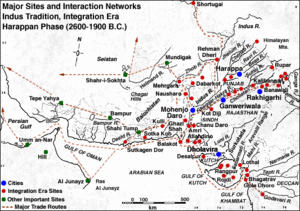Mundigak
| Author:Laxman Burdak, IFS (R) |

Mundigak (Pashto: مونډي ګاګ), in Kandahar, Afghanistan, is an archaeological site in Kandahar province in Afghanistan. It is a site of Indus Valley Civilization.
Location
It's situated approximately 55 km northwest of Kandahar near Shāh Maqsūd, on the upper drainage of the Kushk-i Nakhud River.
Site of Indus Valley Civilization
Mundigak was a large prehistoric town with an important cultural sequence from the 5th-2nd millennia BC. The mound was nine meters tall at the time of excavation.[1]
Pottery and other artifacts of the later 3rd millennium BC, when this became a major urban center, indicate interaction with Turkmenistan, Baluchistan, and the Early Harappan Indus region.
Mundigak flourished during the culture of Helmand Basin (Seistan), also known as Helmand Culture (Helmand Province).[2]
With 21 hectare area, this was the second largest centre of Helmand Culture, the first being Shahr-i-Sokhta which was as large as 150 acres, by 2400 BCE.[3]
Bampur, in Iran, is a closely related site.
Around 2200 BCE, both Shahr-i-Sokhta and Mundigak started declining, with considerable shrinkage in area and with brief occupation at later dates.[4]
Indus Valley links: Mundigak has some Indus Valley Civilization related material. This material consists in part of ceramic figurines of snakes and humped bulls, and other items, similar to those found at other Indus valley sites.[5]
Pottery found at Mundigak had number of similarities with such material found at Kot Diji.[6] This material shows up at the earliest layer of Kot Diji.
Architecture: Remains of a "palace" is found in one mound. Another mound revealed a large "temple", indicating urban life.[7]
An extensive series of mounds marks the site of a town. The chronology is still uncertain, but it has tentatively been divided into seven main periods with many subdivisions. The main period seems to be Period IV, which saw a massive rebuilding after an earlier destruction. Both the "palace" and the "temple" and possibly the city walls as well date from this period. Another destruction layer and a marked ceramic change indicate a period of abandonment between IV and V Periods, followed by a period of further building and construction of new monuments, including the "massive monument". Periods VI & VII saw only periodic occupation on a small scale.
Mundigak and Deh Morasi provide early developments in what may be now called religious activities. A white-washed, pillared large building with its door way outlined with red, dating around 3,000 BC is related to religious activities.[8]
Early houses were constructed at Mundigak (during period I 4) in the form of tiny oblong cells with pressed earth walls. In the following layer (I 5) larger houses with square and oblong houses with sun dried bricks were found/ Ovens for cooking and wells for water storage were found during later phases.[9]
Artifacts found: Apart from pottery and painted pottery, other artifacts found include crude humped bulls, human figures, shaft hole axes,adzes of bronze and terracotta drains.[10]
Painting on pots include pictures of Sacred Fig leaves (ficus religiosa) and tiger like animal. Several stone button seals were also found at Mundigak.[11] Disk Beads and faience barrel beads,[12] copper stamp seals, copper pins with spiral loops were also found.[13]
The female looking human figurines (5 c.m.height) found at Mundigak are very similar to such figurines found at another archeological site in Afghanistan, Deh Morasi Ghundai. (circa 3000 BC)[14]
Collection: BIAS & DAFA - shers; Kabul Museum & Musée Guimet - excavated material.
Field Work: 1951-58 Casal, DAFA - excavasions.
External links
References
- ↑ Afghanistan Prehistory".
- ↑ McIntosh, Jane. (2008) The Ancient Indus Valley, New Perspectives. ABC-CLIO. Page 86
- ↑ McIntosh, Jane. (2008) The Ancient Indus Valley, New Perspectives. ABC-CLIO. Page 87
- ↑ McIntosh, Jane. (2008) The Ancient Indus Valley: New Perspectives. ABC-CLIO. Page 86.
- ↑ "An Encyclopaedia of Indian Archaeology". google.com.
- ↑ McIntosh, Jane. (2008) The Ancient Indus Valley: New Perspectives. ABC-CLIO. Page 75.
- ↑ "An Encyclopaedia of Indian Archaeology". google.com.
- ↑ Afghanistan Prehistory".
- ↑ Bridget and Raymond Allchin. The Birth of Indian Civilization. Penguin Books.1968. Page 237
- ↑ "An Encyclopaedia of Indian Archaeology". google.com.
- ↑ Bridget and Raymond Allchin.(1982) The Rise of Civilisation in India and Pakistan.Page 139
- ↑ Bridget and Raymond Allchin.(1982) The Rise of Civilisation in India and Pakistan.Page 202
- ↑ Bridget and Raymond Allchin.(1982) The Rise of Civilisation in India and Pakistan.Page 232
- ↑ Afghanistan Prehistory".
Back to Indus Valley Civilisation